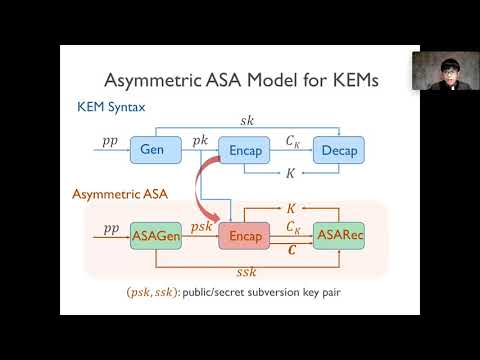CryptoDB
Subvert KEM to Break DEM: Practical Algorithm-Substitution Attacks on Public-Key Encryption
| Authors: | |
|---|---|
| Download: | |
| Abstract: | Motivated by the widespread concern about mass surveillance of encrypted communications, Bellare \textit{et al.} introduced at CRYPTO 2014 the notion of Algorithm-Substitution Attack (ASA) where the legitimate encryption algorithm is replaced by a subverted one that aims to undetectably exfiltrate the secret key via ciphertexts. Practically implementable ASAs on various cryptographic primitives (Bellare \textit{et al.}, CRYPTO'14 \& CCS'15; Ateniese \textit{et al.}, CCS'15; Berndt and Li\'{s}kiewicz, CCS'17) have been constructed and analyzed, leaking the secret key successfully. Nevertheless, in spite of much current attention, the practical impact of ASAs (formulated originally for symmetric key cryptography) on public-key (PKE) encryption operations remains unclear, primarily since the encryption operation of PKE does not involve the secret key and previously known ASAs become relatively inefficient for leaking the plaintext due to the logarithmic upper bound of exfiltration rate (Berndt and Li\'{s}kiewicz, CCS'17). In this work, we formulate a practical ASA on PKE encryption algorithm which, perhaps surprisingly, turns out to be much more efficient and robust than existing ones, showing that ASAs on PKE schemes are far more dangerous than previously believed. We mainly target PKE of hybrid encryption which is the most prevalent way to employ PKE in the literature and in practical systems. The main strategy of our ASA is to subvert the underlying key encapsulation mechanism (KEM) so that the session key encapsulated could be efficiently extracted, which, in turn, breaks the data encapsulation mechanism (DEM) enabling us to learn the plaintext itself. Concretely, our non-black-box attack enables recovering the plaintext from only two successive ciphertexts and minimally depends on a short state of previous internal randomness. A widely used class of KEMs is shown to be subvertible by our powerful attack. Our attack relies on a novel identification and formalization of specific non-black-box yet general enough properties that yield practical ASAs on KEMs. More broadly, this may shed some light on exploring the structural weakness of other composed cryptographic primitives, which may make them susceptible to more dangerous ASAs that surpass the logarithmic upper bound of exfiltration rate on universal ASAs. |
Video from ASIACRYPT 2020
BibTeX
@article{asiacrypt-2020-30701,
title={Subvert KEM to Break DEM: Practical Algorithm-Substitution Attacks on Public-Key Encryption},
booktitle={Advances in Cryptology - ASIACRYPT 2020},
publisher={Springer},
doi={10.1007/978-3-030-64834-3_4},
author={Rongmao Chen and Xinyi Huang and Moti Yung},
year=2020
}

